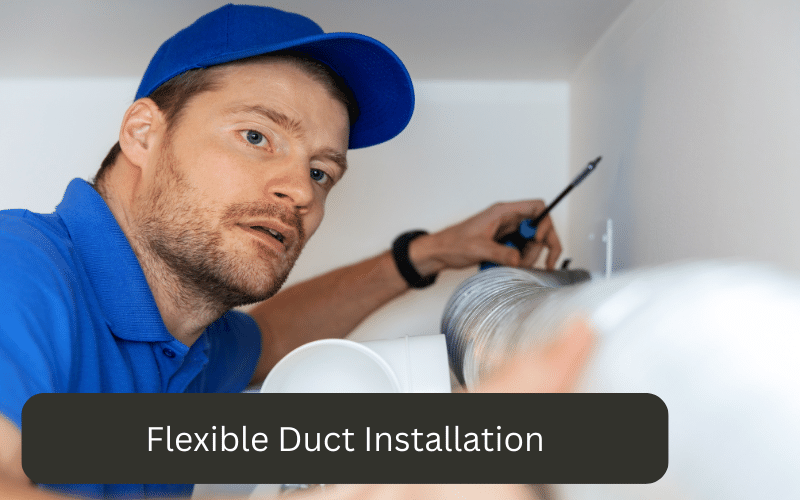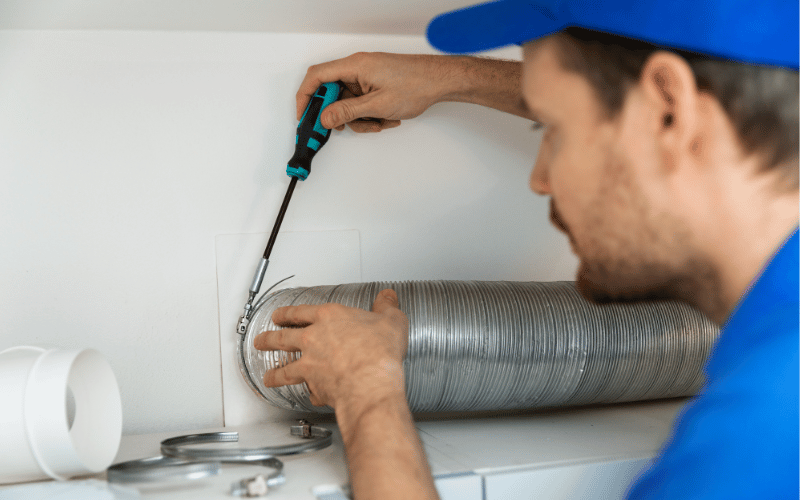In the world of HVAC systems, flexible duct installation is a growing preference for modern systems. Flexible ducts are easier to install and offer numerous advantages over rigid ducts. Energy HVAC Services is a leading expert in the installation of flexible ducts. In this article, we will discuss the benefits of flexible duct installation, common mistakes to avoid, and maintenance and aftercare tips for flexible ducts to ensure the longevity and efficiency of your system.
What is a Flexible Duct?
A Flexible Duct, commonly referred to as ‘flex’, is a type of ductwork that is known for its versatility. Unlike rigid ductwork, flexible ducts don’t require joints, hence they can be bent around obstacles making installation less complicated. Made from a spiral wire ribbed interior and enclosed by a layer of flexible plastic, they’re designed to fit into tight spaces where traditional ducts wouldn’t be feasible.

As implied by the name, their key characteristic is flexibility which allows for easy adaptation to the structural contours of the building. This feature also provides a cost-effective and efficient solution for HVAC system setup across various environments.
Benefits of Using Flexible Ducts
Flexible duct installation offers a range of benefits that make it the preferred choice for many modern HVAC systems:
- Ease of Installation: Flexible ducts are relatively easy to install compared to their rigid counterparts, reducing the time and labor costs.
- Versatility: Thanks to their flexibility, these ducts can be maneuvered around obstacles, allowing for installation in tight or awkward spaces.
- Cost-Effective: Because they don’t require multiple joints and fixtures like rigid ducts, flexible ducts can be a more economical option.
- Noise Reduction: Flexible ducts can absorb noise and vibration from the HVAC system, leading to a quieter operation.
- Efficient Energy Use: When installed correctly, flexible ducts can provide efficient air distribution, helping to reduce energy consumption and costs.
- Adaptable: They can be easily adjusted or expanded to accommodate changes in the building structure or HVAC system.
Common Mistakes & How to Avoid Them
Despite the numerous benefits of flexible ducts, there are common mistakes made during installation that can undermine their efficiency:
- Incorrect Sizing: A common mistake is choosing a duct size that doesn’t match the capacity of the HVAC system. This can lead to inefficiency and higher energy consumption. To avoid this, ensure you accurately measure the system’s airflow needs before selecting the duct size.
- Excessive Length: Using excessive lengths of flex duct can cause air flow restriction, reducing the system’s efficiency. Avoid this by cutting the duct to the exact length required.
- Sharp Bends: Sharp bends in the ductwork can cause resistance to airflow. Ensure that the ducts are installed with gradual bends to maximize airflow.
- Poorly Sealed Joints: Joints that are poorly sealed lead to air leaks, causing inefficiency and higher energy costs. Use mastic sealant or metal tape to properly seal all joints.
- Lack of Support: Flex ducts that are not properly supported can sag over time, leading to airflow restriction. Support the ductwork at regular intervals to prevent this.
- Insufficient Insulation: Without proper insulation, heat can be lost which reduces efficiency. Ensure all ductwork is properly insulated.
To avoid these common mistakes, it is important to work with an experienced HVAC contractor who can ensure proper installation.
Maintenance and Aftercare
Maintaining your flexible ductwork properly and ensuring appropriate aftercare can significantly enhance the lifespan and performance of your HVAC system. Here are some key points to remember:
- Regular Inspections: Conduct routine checks to identify any signs of damage or wear and tear. Early detection can prevent minor issues from escalating into major problems.
- Cleaning: Keep the ducts clean to ensure efficient airflow. Accumulation of dirt or debris can cause blockages, affecting the system’s performance.
- Seal Check: Regularly check the seals for any leaks. If you notice any, repair them promptly to prevent energy loss.
- Insulation Check: Inspect the insulation regularly to ensure it is still in good condition. Replace any damaged or worn insulation to maintain the efficiency of your system.
- Professional Maintenance: Schedule professional maintenance from a certified HVAC contractor at least once a year. An experienced professional can thoroughly inspect your system and address any hidden issues.
- Update Installation: Over time, you may need to adjust or expand your ductwork to accommodate changes in your building structure or HVAC system. Ensure these updates are done by a professional to maintain optimal function.
Conclusion
In conclusion, flexible duct installation is an attractive and cost-effective option for modern HVAC systems. Proper installation is crucial for ensuring system efficiency and longevity. Energy HVAC Services is a trusted HVAC contractor and expert in the installation of flexible ducts. Our team has the knowledge and experience to help you install and maintain a system that meets your individual needs. Contact us today to learn more about our flexible duct installation services and how we can help your system function optimally.
More Articles:
- Split AC Installation Cost: Your Guide to Understanding and Reducing Costs
- Why Professional Air Duct Vent Installation Matters for Indoor Air Quality
- Bulkhead Air Conditioner Installation – Importance and Benefits
Frequently Asked Questions
How long do flexible ducts typically last compared to rigid ducts?
Flexible ducts typically have a shorter lifespan than rigid ducts, often lasting around 10 to 15 years with proper care. In contrast, rigid ducts can last 15 to 25 years or more, depending on material and maintenance. The durability of flexible ducts can be compromised more easily due to physical damage or deterioration.
What are the main advantages of using flexible ducts?
Flexible ducts are easier and quicker to install, especially in tight spaces or complex configurations. They are lightweight and can be maneuvered around obstacles without requiring multiple fittings. Additionally, they are often more cost-effective than rigid duct options for certain applications
Is the cleaning process for flexible ducts different from rigid ones?
Yes, flexible ducts require a gentler cleaning approach than rigid ducts to prevent damage or tearing. While both types can be cleaned using specialized brushes and vacuums, care must be taken with flexible ducts to avoid excessive force or sharp tools that could compromise their integrity.





